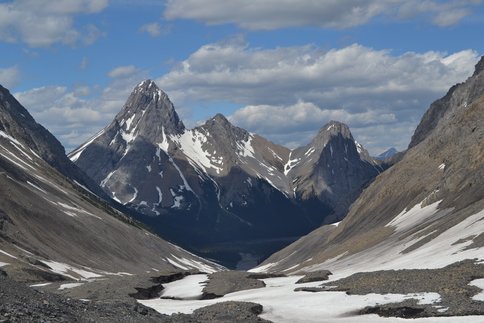2015 Annual Science Report
 University of Colorado, Boulder
Reporting | JAN 2015 – DEC 2015
University of Colorado, Boulder
Reporting | JAN 2015 – DEC 2015
Subglacial Environments as Water‐Rock Hosted Microbial Ecosystems
Project Summary
Glaciers, ice sheets and ice caps cover ~11% of the earth’s surface, and likely covered up to 100% during Neoproterozoic glaciations. The beds of these ice masses can have significant sectors at the pressure melting point. The resulting water lubricates ice sliding and accelerates erosion, provides habitat for subglacial microbial ecosystems, and may have acted as refugia during past global glaciations on Earth. Such environments may also act as habitats for life on other planetary bodies.
Grinding of bedrock by glaciers exposes fresh mineral surfaces capable of sustaining microbial metabolism. The foci of RPL investigations on subglacial environments are categorized into two key areas of relevance to habitability studies: i) determine the extent to which minerals support chemotrophic metabolism and the production of biosignatures (e.g., weathering products), and ii) quantifying the influence of water-rock interactions in supplying substrates to support energy metabolism. Through these interdisciplinary and collaborative studies, we aim to characterize the active microbial processes in subglacial environments and to define the sources of energy that sustains this microbial life.
Project Progress
To investigate the role of minerals in sustaining subglacial communities the stream water chemistry and the bacterial community composition were analyzed in two catchments containing identical sedimentary formations and differing only in the extent of glaciation. The two catchments, glaciated Dryadbreen and unglaciated Fardalen, are located in Svalbard, Norway. Stream waters from both catchments were analyzed for major ions and stable isotopes and associated stream sediments were analyzed by 16S rRNA gene tagged sequencing. Sulfate was the dominant anion in both catchments, indicating that pyrite weathering and concomitant production of sulfuric acid is a significant weathering agent in both catchments. Stable isotope measurements of sulfate, together with inferences of metabolic processes catalyzed by resident microbial communities, revealed that the pyrite oxidation reaction differed between the two catchments. No δ34S fractionation relative to pyrite was observed in the unglaciated catchment and this was interpreted to reflect pyrite oxidation under oxic conditions. In contrast, δ34S and δ18OSO4 values were positively correlated in the glaciated catchment and were positively offset from pyrite. This was interpreted to reflect pyrite oxidation under anoxic conditions with loss of S intermediates. These observations suggest the potential for minerals to sustain microbial metabolism under ice in the presence and absence of oxygen.
Our previous work in subglacial environments suggest the presence of an abundant population of putatively hydrogenotrophic methanogens. However, a biological source for the hydrogen supporting these communities could not be identified suggesting that the hydrogen was being supplied by abiotic mechanisms. To investigate the potential for water-rock interactions to supply the hydrogen supporting the abundant methanogen communities in subglacial environments, we mimicked the physical abrasion of silicate bedrock by glaciers in the laboratory and showed hydrogen production when rock flour was exposed to water at 0°C. The hydrogen is likely produced via the reaction of water with surface silica radicals formed during glacial rock comminution. Rates of hydrogen production from this mechanism is sufficient to support previous measured rates of hydrogenotrophic methanogenesis in these ecosystems. We conclude that H2 generation from glacial bedrock comminution is a potentially significant source of energy that can help support a dark, cold subglacial biosphere on Earth, and possibly other planetary bodies where silicate bedrock and glacial ice exist.
Publications
-
Hindshaw, R. S., Heaton, T. H. E., Boyd, E. S., Lindsay, M. R., & Tipper, E. T. (2016). Influence of glaciation on mechanisms of mineral weathering in two high Arctic catchments. Chemical Geology, 420, 37–50. doi:10.1016/j.chemgeo.2015.11.004
-
Telling, J., Boyd, E. S., Bone, N., Jones, E. L., Tranter, M., MacFarlane, J. W., … Hodgson, D. A. (2015). Rock comminution as a source of hydrogen for subglacial ecosystems. Nature Geosci, 8(11), 851–855. doi:10.1038/ngeo2533
-
PROJECT INVESTIGATORS:
-
PROJECT MEMBERS:
Everett Shock
Co-Investigator
Mark Skidmore
Co-Investigator
Trinity Hamilton
Collaborator
Melody Lindsay
Collaborator
-
RELATED OBJECTIVES:
Objective 2.1
Mars exploration.
Objective 5.1
Environment-dependent, molecular evolution in microorganisms
Objective 5.2
Co-evolution of microbial communities
Objective 5.3
Biochemical adaptation to extreme environments
Objective 6.1
Effects of environmental changes on microbial ecosystems
Objective 6.2
Adaptation and evolution of life beyond Earth
Objective 7.2
Biosignatures to be sought in nearby planetary systems


